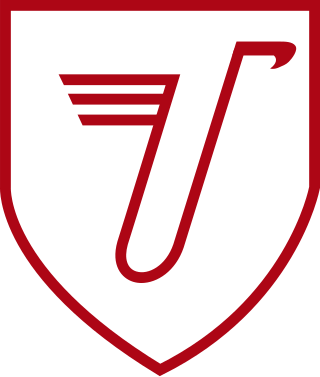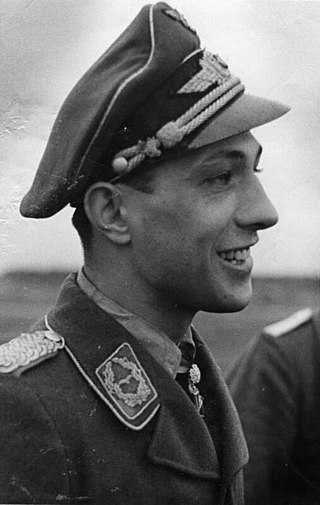
The Junkers Ju 87, popularly known as the "Stuka", is a German dive bomber and ground-attack aircraft. Designed by Hermann Pohlmann, it first flew in 1935. The Ju 87 made its combat debut in 1937 with the Luftwaffe's Condor Legion during the Spanish Civil War of 1936–1939 and served the Axis in World War II from beginning to end (1939–1945).

The Focke-Wulf Fw 190, nicknamed Würger (Shrike) is a German single-seat, single-engine fighter aircraft designed by Kurt Tank at Focke-Wulf in the late 1930s and widely used during World War II. Along with its well-known counterpart, the Messerschmitt Bf 109, the Fw 190 became the backbone of the Jagdwaffe of the Luftwaffe. The twin-row BMW 801 radial engine that powered most operational versions enabled the Fw 190 to lift larger loads than the Bf 109, allowing its use as a day fighter, fighter-bomber, ground-attack aircraft and to a lesser degree, night fighter.

Gerhard "Gerd" Barkhorn was a German military aviator who was a renowned wing commander in the Luftwaffe during World War II. As a fighter ace, he was the second most successful fighter pilot of all time after fellow pilot Erich Hartmann. Other than Hartmann, Barkhorn is the only fighter ace to ever exceed 300 claimed victories. Following World War II, he became a high-ranking officer in the German Air Force of the Federal Republic of Germany.

Jagdgeschwader 54 Grünherz was a Luftwaffe fighter wing that was founded in late 1936 and operated from 1939, the entire length of the Second World War. It later existed under the reformed Luftwaffe from 1947 to 1991 as BG54/B54 A B and C. Originally, JG 54 flew most of its missions on the Eastern Front where it claimed more than 9,600 aircraft shot down. It was the second-highest scoring wing in the Luftwaffe after JG 52. Notable pilot aces (Experten) that flew with JG 54 included Walter Nowotny, Walter Boerner,Otto Kittel, Hans-Ekkehard Bob, Max-Hellmuth Ostermann, Hugo Broch, Horst Ademeit and Hannes Trautloft.

Jagdgeschwader 3 "Udet" was a Luftwaffe fighter wing of World War II. The Geschwader operated on all the German fronts in the European Theatre of World War II. It was named after Ernst Udet, an important figure in the development of the Luftwaffe, in 1942.

Erich Rudorffer was a German Luftwaffe fighter ace who was one of a handful who served with the Luftwaffe through the whole of World War II. He was one of the most successful fighter pilots in the history of air warfare, with 222 victories claimed. Rudorffer fought in all the major German theaters of war, including the European and Mediterranean Theater of Operations and the Eastern Front. During the war he flew more than 1000 combat missions, engaging in aerial combat over 300 times. Rudorffer was shot down by flak and enemy fighters 16 times and had to take to his parachute nine times.

Major Theodor Nordmann was a World War II Luftwaffe Stuka ace. He was also a recipient of the Knight's Cross of the Iron Cross with Oak Leaves and Swords. The Knight's Cross of the Iron Cross and its higher grade Oak Leaves and Swords was awarded to recognise extreme battlefield bravery or successful military leadership.
Schlachtgeschwader 2 Immelmann was a Luftwaffe dive-bomber wing of World War II. It was named after Max Immelmann, the first German pilot to earn the Pour le Mérite.

Luftflotte 1 was one of the primary divisions of the German Luftwaffe in World War II. It was formed on 1 February 1939 from Luftwaffengruppenkommando 1 in Berlin. This Luftwaffe detachment served in Estonia, Latvia, Lithuania and Finland, supporting Axis forces in area; with command offices in Malpils, Latvia,, Eastern front.
Kurt Kuhlmey was a general in the West German Air Force. During World War II, he served as ground-attack aircraft pilot in the Luftwaffe, commanding two air wings. Kuhlmey flew over 500 combat missions, and in July 1942 was awarded the Knight's Cross of the Iron Cross.

Franz Eisenach was a German fighter ace during World War II and a recipient of the Knight's Cross of the Iron Cross of Nazi Germany. He was credited with 129 aerial victories claimed in 319 combat missions, all on the Eastern front of the Second World War.

Schlachtgeschwader 1 was a German Luftwaffe wing during World War II. It operated the Henschel Hs 123, Henschel Hs 129, Focke-Wulf Fw 190, and the Messerschmitt Bf 109.
During the Second World War the German Luftwaffe was the main support weapon of the German Army (Heer). It fought and supported the Wehrmacht's war effort throughout the six years of conflict and contributed to much of Nazi Germany's early successes in 1939–1942. After the turn in Germany's fortunes, it continued to support the German ground forces until the German surrender in May 1945.

The Focke-Wulf Fw 190 Würger was used by the Luftwaffe during the Second World War in a variety of roles. Like the Messerschmitt Bf 109, the Fw 190 was employed as a "workhorse", and proved suitable for a wide variety of roles, including air superiority fighter, strike fighter, ground-attack aircraft, escort fighter, and operated with less success as a night fighter. It served on all the German fronts: Eastern Front, Western Front, North African Campaign and the Defence of the Reich.

Schlachtgeschwader 3 was a Luftwaffe close air support Geschwader during World War II. It was formed on 18 October 1943 in Eleusis from Sturzkampfgeschwader 3. A special detachment was formed 13 June 1944 to 13 August 1944 referred to as Detachment Kuhlmey. The detachment was built around elements of I./SG 3, I./SG 5, II./JG 54 and NaGr.1

Willi Reschke was a Luftwaffe ace and recipient of the Knight's Cross of the Iron Cross during World War II, credited with 27 aerial victories in 70 missions. In 1999, Reschke recounted his wartime experiences in print, published in English in 2005 as "Jagdgeschwader 301/302 'Wilde Sau': In Defense Of The Reich with the Bf 109, Fw 190 and Ta 152;" including writing about the late-war period he spent flying the exotic Focke-Wulf Ta 152 high-altitude fighter-interceptor designed by Kurt Tank.
Hobart Barracks is a former military airfield, located 1.6 km east-northeast of Detmold in North Rhine-Westphalia, Germany.

Schnellkampfgeschwader 10 was a Luftwaffe fast bomber wing of the Second World War. The unit was initially created with three Gruppen (groups) in December 1942 at Saint-André-de-l'Eure Airport and augmented by a fourth group on 10 April 1943.
Friedrich-Wilhelm Strakeljahn was a German Luftwaffe military aviator during World War II, a fighter ace listed with at least nine enemy aircraft shot down in over 300 combat missions. As a commander of fighter bombers, his unit was credited with the destruction of 39,000 gross register tons (GRT) of Allied shipping. On 6 July 1944, Strakeljahn was killed in action, shot down by Soviet anti-aircraft artillery near Daugavpils.














